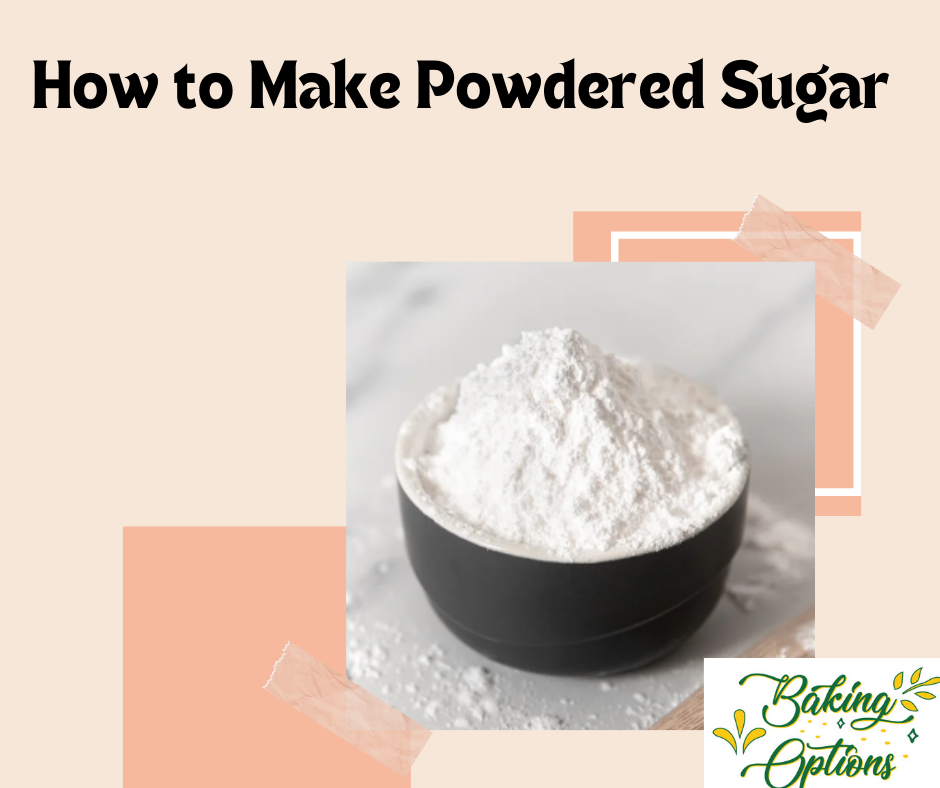Have you experienced a situation where you made a recipe which required powdered sugar only to discover your missing ingredient while forgetting to get it from the market? It happened to me once when I was a beginner cook, and then I thought about how to make powdered sugar at home.
I checked out various methods on YouTube, articles, and much more. I found one method I liked because it was pretty simple, and since my recipe was half-ready, this method would be suitable. I couldn’t believe this problem could be solved in just a few minutes.
In this article, I want to share this method with you because I hope you find it useful, as powdered sugar is essential in baking, especially.
Contents
What Is Powdered Sugar & Why We Need It?
Confectioner’s sugar and icing sugar are other names for powdered sugar. It is usually used in baking and similar applications.
They usually add cornstarch to prevent lumps from forming if you buy it from outside. However, if you make it home, you can add something else instead of cornstarch.
What You’ll Need
Ingredients
- White granulated sugar (the main ingredient)
- Cornstarch (optional, but recommended)
Equipment
- High-speed blender, food processor, or powerful spice grinder
- Measuring cups & spoons
- Airtight storage container
- Sifter or fine-mesh strainer (optional, but it is helpful, so recommended)
Step-by-Step Process
Measure Your Ingredients
The basic ratio is simple
- 1 cup of granulated sugar
- 1 tablespoon of cornstarch (not essential but advisable)
This little amount of cornstarch will ensure that your powdered sugar is exactly that—powdery—and doesn’t form clumps.
However, if you do not have cornstarch, you can still make powdered sugar, but the quality and ways of storing it may not be as effective.
2. Blending Technique
Finally, add sugar (and cornstarch) to your blender or food processor.
- Cover the lid securely.
- Mix for one to thirty seconds at high speed.
- Stop and ensure that the material is evenly distributed.
- If required, run the blender for another 30 seconds.
Pro Tip: Different blenders complete tasks at different speeds. Using a high-end blender might take longer than using a less powerful one.
3. Texture Check
The perfect powdered sugar should:
- It feels extremely fine and soft
- They should have no graininess when rubbed between fingers
- It looks like the store bought one
- Have a powdery, white appearance.
Homemade Powdered Sugar Storing Tips
If you want to store it, keep it in an airtight container at room temperature. You can easily use it for up to four months. If it becomes a little clumpy, just sift it once before using it; it will return to its normal condition.
Troubleshooting Issues
Sugar isn’t grinding fine enough
For one common reason, sugar doesn’t blend well: we tend to blend too much sugar at once. To achieve a fine consistency, divide the sugar into small batches and blend them. This helps:
- The sugar blends well.
- The blender machine won’t get overloaded.
- We achieve the right consistency that we need for powdered sugar.
Use A Clean Dry Blender
Firstly, ensure that the blender being used is clean and dry all the time
Do you know what can be terrible for powdered sugar? You guess, yes, moisture it is! Even a tiny bit of water can cause problems.
- Water is a solvent that causes sugar to coalesce or lump together.
- Humidity due to dampness can produce moist and sticky forms of sugar, which is not easy to use.
- Water can make sugar start dissolving.
- Food particles left behind can alter the flavor or consistency of the powdered sugar
So before you start:
- Wash your blender thoroughly
- With a fresh towel, pat it dry till it becomes dry.
- Give it some time to air dry for a few more minutes if you can.
- If water droplets are present inside, make sure there is none left.
Let the sugar settle
After blending, do not open the lid immediately; wait for a few seconds and let the sugar settle properly. No one may tell you this, but I’m sharing it from my experience. I will share the reasons behind this so you may remember if you have faced something similar.
- It prevents the sugar from going into the eyes.
- It doesn’t create a mess in the kitchen.
- It doesn’t float in the air, so it’s not wasted.
To prevent it, follow these simple steps:
- After you blend, pause for 30-60 seconds.
- Leave the sugar or any powder to settle at the bottom of the blender.
- Open the lid slowly & carefully to avoid a cloud of dust.
- To be safe, you should cover the top with a kitchen towel when you open it.
- Always blend in a well-ventilated space to keep fresh air flowing.
Pro Tip: If you have a breathing issue, wear a light mask before blending sugar. Safety always comes first, so I strongly advise wearing a mask, especially when blending several batches.
Creative Ways to Use Powdered Sugar in Your Cooking
In this whole article, I think this point is my favorite. 😀 I’m Kidding, well.
Dusting Desserts
Consider turning a simple recipe into an attractive & creative dessert with a sprinkle. You can achieve a snowy appearance with powdered sugar over brownies, cakes and pastries and other desserts. As you eat the dessert the powdered sugar gives an appealing visual effect but tastes smooth on your tongue.
Making Frosting and Icing
Trust me, this powdered sugar is a Favourite ingredient of professional chefs. You can perform many decorations with it.
Using homemade powdered sugar can boost the look if you’re preparing delicious frosting like vanilla buttercream or cream cheese frosting.
Cornstarch helps keep the frosting stiff and makes it easy to pipe decorations that hold their shape nicely. This way, your baked goods will taste great and look professional.
Creating Delicate Sugar Garnishes
You can make sugar cages by carefully filtering sugar over parchment paper, creating complex patterns on dessert plates, or even using it to add the final finishing touch to puddings and other soft desserts. It’s like adding a little bit of beautiful and delicious sweetness.
How To Use a Coffee Grinder To Make Powdered Sugar?
The device helps you grind sugar because its essential function is to blend coffee beans into powder which also applies to sugar. All you have to do is a batch of sugar, and you can get the same consistency of powdered sugar through this process.
Simple step-by-step Process
- Clean the Grinder
The first and foremost step is washing and cleaning. Whether it’s a blender or a coffee grinder, you should wash and then clear it carefully. There should be no moisture while you can’t get the right consistency.
- Add Sugar
The next step is to add sugar. Measure how much sugar you want. And remember, beginners usually make mistakes here. Half a cup of granulated sugar is the entire cup of powdered sugar. This quantity changes due to a volume change.
- Start Grinding
Put your sugar into a grinder. Grind it in short spurts for about 30 seconds to 1 minute. Make sure to take breaks in between to let the grinder cool down. It helps prevent the sugar from melting and keeps the grinder working correctly.
- Optional Ingredient
Add one tablespoon of cornstarch for each cup if you want to store the powdered sugar longer without getting clumpy.
After you’re done grinding, feel the sugar between your fingers. It should feel soft and fluffy. If it still feels a bit grainy, grind it a little more until it gets to the texture you want.
Final Words
Now, if you know how to make powdered sugar at home, let me tell you the benefits of preparing it yourself. When we make it at home, we can try it with different sugars.
Otherwise, this sugar is readily available in shops and isn’t expensive, but we need flexible options there. Plus, chefs should know everything.

